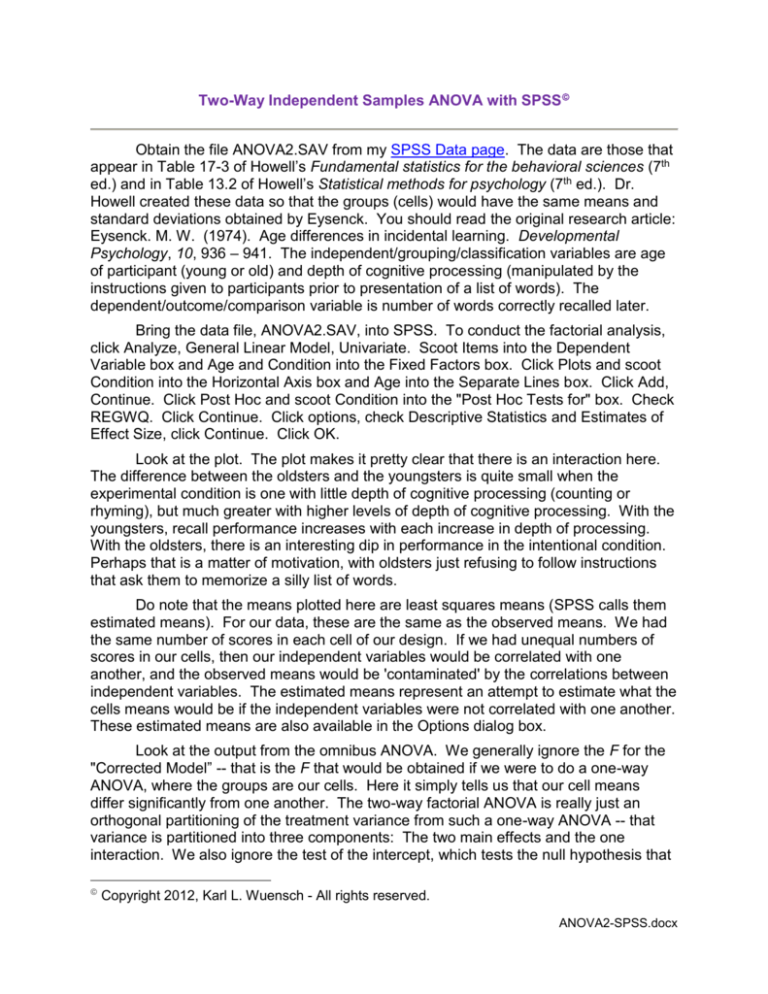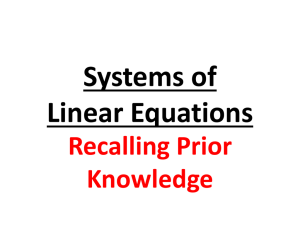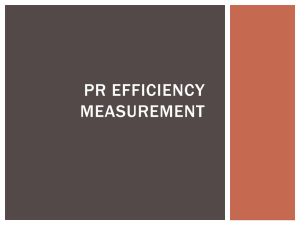
Two-Way Independent Samples ANOVA with SPSS
Obtain the file ANOVA2.SAV from my SPSS Data page. The data are those that
appear in Table 17-3 of Howell’s Fundamental statistics for the behavioral sciences (7th
ed.) and in Table 13.2 of Howell’s Statistical methods for psychology (7th ed.). Dr.
Howell created these data so that the groups (cells) would have the same means and
standard deviations obtained by Eysenck. You should read the original research article:
Eysenck. M. W. (1974). Age differences in incidental learning. Developmental
Psychology, 10, 936 – 941. The independent/grouping/classification variables are age
of participant (young or old) and depth of cognitive processing (manipulated by the
instructions given to participants prior to presentation of a list of words). The
dependent/outcome/comparison variable is number of words correctly recalled later.
Bring the data file, ANOVA2.SAV, into SPSS. To conduct the factorial analysis,
click Analyze, General Linear Model, Univariate. Scoot Items into the Dependent
Variable box and Age and Condition into the Fixed Factors box. Click Plots and scoot
Condition into the Horizontal Axis box and Age into the Separate Lines box. Click Add,
Continue. Click Post Hoc and scoot Condition into the "Post Hoc Tests for" box. Check
REGWQ. Click Continue. Click options, check Descriptive Statistics and Estimates of
Effect Size, click Continue. Click OK.
Look at the plot. The plot makes it pretty clear that there is an interaction here.
The difference between the oldsters and the youngsters is quite small when the
experimental condition is one with little depth of cognitive processing (counting or
rhyming), but much greater with higher levels of depth of cognitive processing. With the
youngsters, recall performance increases with each increase in depth of processing.
With the oldsters, there is an interesting dip in performance in the intentional condition.
Perhaps that is a matter of motivation, with oldsters just refusing to follow instructions
that ask them to memorize a silly list of words.
Do note that the means plotted here are least squares means (SPSS calls them
estimated means). For our data, these are the same as the observed means. We had
the same number of scores in each cell of our design. If we had unequal numbers of
scores in our cells, then our independent variables would be correlated with one
another, and the observed means would be 'contaminated' by the correlations between
independent variables. The estimated means represent an attempt to estimate what the
cells means would be if the independent variables were not correlated with one another.
These estimated means are also available in the Options dialog box.
Look at the output from the omnibus ANOVA. We generally ignore the F for the
"Corrected Model” -- that is the F that would be obtained if we were to do a one-way
ANOVA, where the groups are our cells. Here it simply tells us that our cell means
differ significantly from one another. The two-way factorial ANOVA is really just an
orthogonal partitioning of the treatment variance from such a one-way ANOVA -- that
variance is partitioned into three components: The two main effects and the one
interaction. We also ignore the test of the intercept, which tests the null hypothesis that
Copyright 2012, Karl L. Wuensch - All rights reserved.
ANOVA2-SPSS.docx
2
the mean of all the scores is zero. If you divide each effect's SS by the total SS, you
see that the condition effect accounts for a whopping 57% of the total variance, with the
age effect only accounting for 9% and the interaction only accounting for 7%. Despite
the fact that all three of these effects are statistically significant, one really should keep
that in mind, and point out to the readers of the research report that the age and
interaction effects are much less in magnitude than is the effect of recall condition
(depth of processing).
Look at the within-cell standard deviations. In the text book, Howell says "it is
important to note that the data themselves are approximately normally distributed with
acceptably equal variances." I beg to differ. Fmax is 4.52 / 1.42 > 10 -- but I am going to
ignore that here.
The interpretation of the effect of age is straightforward -- the youngsters recalled
significantly more items than did the oldsters, 3.1 items on average. The pooled withinage standard deviation is computed by taking the square root of the mean of the two
4.0072 5.7872
4.977 . The standardized difference,
2
d, is then 3.1/4.977 = .62. Using Cohen's guidelines, that is a medium to large sized
effect. In terms of percentage of variance explained,
SSage
240.25
2
.09.
SSCorrected _ Total 2667.79
groups’ variances -- spooled
The interpretation of the recall condition means is also pretty simple. With
greater dept of processing, recall is better, but the difference between the intentional
condition and the imagery condition is too small to be significant, as is the difference
between the rhyming condition and the counting condition. The pooled standard
deviation within the intentional recall and the counting conditions is
4.9022 1.6182
3.65 . Standardized effect size, d, is then
2
15.65 6.75
2.44 , an enormous effect. In terms of percentage of variance explained
3.65
1514.94
by recall condition, 2
.57.
2667.79
spooled
Although the significant interaction effect is small (2 = .07) compared to the main
effect of recall condition, we shall investigate it by examining simple main effects. For
pedagogical purposes, we shall obtain the simple main effects of age at each level of
recall condition as well as the simple main effects of recall condition for each age.
Notice that SPSS gives you values of partial eta-squared. Also note that they
sum to more than 100% of the variance. If you want to place confidence intervals on
the obtained values of eta-squared, you must compute an adjusted F for each effect, as
I have shown you elsewhere. To place confidence intervals on partial eta-squared you
need only the F and df values that SPSS reports. Using the NoncF script, here are the
confidence intervals:
3
Return to the Data Editor. Click Data, Split File. Tell SPSS to organize the
output by groups based on the Condition variable. OK. Click Analyze, Compare
Means, One-Way ANOVA. Scoot Items into the Dependent List and Age into the Factor
box. OK.
The results show that the youngsters recalled significantly more items than did
the oldsters at the higher levels of processing (adjective, imagery, and intentional), but
not at the lower levels (counting and rhyming). The tests we have obtained here
employ individual error terms – that is, each test is based on error variance from only
the two groups being compared. Given that there is a problem with heterogeneity of
variance among our cells, that is actually a good procedure. If we did not have that
problem, we might want to get a little more power by using a pooled error term. What
we would have to do is take the treatment MS for each of these tests, divide it by the
error MS from the overall factorial analysis, and evaluate each resulting F with the same
error df used in the overall ANOVA. Our error df would then be 90 instead of 18, which
would give us a little more power.
Return to the Data Editor. Click Data, Split File. Tell SPSS to organize the
output by groups based on the Age variable. OK. Click Analyze, Compare Means,
One-Way ANOVA. Leave Items in the Dependent List and replace Age with Condition
in the Factor box. OK.
Note that the effect of condition is significant for both age groups, but is larger in
magnitude for the youngsters (2 = .83) than for the oldsters (2 = .45). I don't think that
the pairwise comparisons here add much to our understanding, but lets look at them
briefly. Among the oldsters, mean recall in the adjective, intentional, and imagery
conditions was significantly greater than in the rhyming and counting conditions.
Among the youngsters, mean recall in the adjective conditions was significantly greater
than that in the counting and rhyming conditions and significantly less than that in the
imagery and intentional conditions.
4
Writing up the Results – Here is an Example
A 2 x 5 factorial ANOVA was employed to determine the effects of age group and
recall condition on participants’ recall of the items. A .05 criterion of statistical
significance was employed for all tests. The main effects of age, F(1, 90) = 29.94,
p < .001, p2 = .25, 95% CI [.11, .38], and recall condition, F(4, 90) = 47.19, p < .001,
p2 = .68, 95% CI [ .55, .74], were statistically significant, as was their interaction, F(4,
90) = 5.93, p < .001, p2 = .21, 95% CI [.05, .32]; MSE = 8.03 for each effect. Overall,
younger participants recalled more items (M = 13.16) than did older participants (M =
10.06). The REGWQ procedure was employed to conduct pairwise comparisons on the
marginal means for recall condition. As shown in the table below, recall was better for
the conditions which involved greater depth of processing than for the conditions that
involved less cognitive processing.
Table 1. The Main Effect of Recall Condition
Recall Condition
Mean
Counting
Rhyming
Adjective
Imagery
Intentional
6.75 A
7.25A
12.90B
15.50C
15.65C
Note. Means sharing a letter in their superscript are not significantly
different from one another according to REGWQ tests.
The interaction is displayed in the following figure. Recall condition had a
significant simple main effect in both the younger participants, F(4, 45) = 53.06,
MSE = 6.38, p < .001, 2 = .83, 95% CI [.70, .87] and the older participants, F(4, 45) =
9.08, MSE = 9.68, p < .001, 2 = .45, 95% CI [.18, .57], but the effect was clearly
stronger in the younger participants than in the older participants. The younger
participants recalled significantly more items than did the older participants in the
adjective condition, F(1, 18) = 7.85, MSE = 9.2, p = .012, 2 = .30, 95% CI [.02, .55], the
imagery condition, F(1, 18) = 6.54, MSE = 13.49, p = .020, 2 = .27, 95% CI [.005, .52],
and the intentional condition, F(1, 18) = 25.23, MSE = 10.56, p < .001, 2 = .58, 95% CI
[.23, .74], but the effect of age fell well short of significance in the counting condition,
F(1, 18) = 0.46, MSE = 2.69, p = .50, 2 = .03, 95% CI [00, .25], and in the rhyming
condition, F(1, 18) = 0.59, MSE = 4.18, p = .45, 2 = .03, 95% CI [.00, .27].
It could be argued that we should be reporting 90% rather than 95% confidence
intervals here. With α set at .05, it is possible for the F test to be significant but the
confidence interval include zero. If the confidence coefficient is set to 90% (1 - 2α) then
the confidence interval is absolutely equivalent to the F test.
5
Recall in Young and Old Participants
Mean Items Recalled
20
Young
15
Old
10
5
Counting
Rhyming
Adjective
Imagery
Intentional
R
Recall Condition
Return to the SPSS Lessons Page
Copyright 2012, Karl L. Wuensch - All rights reserved.







